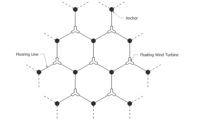Pipe-flow turbulence is a problem in the transport of oil, water and other fluids, and once established, it is persistent and costly. Turbulent fluids consume greater pumping energy and can cause internal corrosion. But Austrian researchers have come up with several possible solutions to the problem.
In contrast to laminar flow, in which the fluid moves in smooth layers, turbulence is characterized by huge, rapid fluctuations and strong vortices, greatly increasing energy losses through frictional drag, heat transfer and fluid mixing. Now, an Institute of Science and Technology Austria research team has successfully demonstrated a way to destabilize turbulence and convert it to laminar flow. Reducing turbulence can reduce energy demand for pumping by as much as 95%, the researchers claim.
The key is to disturb the velocity profile in the turbulent pipe flow. Fluids in a pipeline flow fastest at the center but are slowed by friction near the pipe wall. The research team, led by Professor Björn Hof, disturbed the velocity profile using several techniques: placing rotors in the flow near the wall to reduce the difference in velocity between the center and the wall; injecting liquid from the wall; or impulsively accelerating a slightly larger section of pipe wall in a streamwise direction and abruptly stopping. Each method flattened the velocity profile by creating additional vortices that redistributed the flow, resulting in a laminar flow.
“A profile modification alone suffices to destabilize turbulence,” wrote Jakob Kühnen, who, with others, designed and conducted the experiments and analyzed the results. All the techniques produced satisfactory results, and the downstream flow stayed laminar as long as it did not encounter perturbations, such as bends, valves or imperfect welds.
That last condition highlights the very early stage of development of systems for implementing the fluid-profile modifiers in the field. “It’s more a proof of principle than a ready-made product,” Kühnen says, adding that if the principle can be scaled up for commercial application, the techniques should work at any velocity.
“Rough estimates for current electricity prices showed that we would need pipeline sections which are straight for at least 3 to 5 kilometers in order to justify the installation of a device to make a flow laminar,” Kühnen says. “Even though our method can … save up to 95% of the required pumping energy in a straight pipe, which is a fantastic value almost too good to be true, the way to a real-world application could be long and require more R&D.”
Another practical challenge is the need for frequent cleaning and inspection of pipelines, known as pigging.
Inserted into a pipe, a pig is a device that inspects the length of a pipe. “Any device mounted within the pipeline would need a design which allows for pigging,” Kühnen says. In the IST Austria experiments, one of the flow-management devices allows streamwise injection through an annular gap and seems most promising for that reason, he says.
Pipeline turbulence also creates internal corrosion as well as distribution and operational challenges, says Cliff Johnson, president of Pipeline Research Council International Inc. Successful development of this technology could meet a critical need, he says. IST Austria’s claim of 95% cost saving “seems overambitious,” adds Gary Choquette, a PRCI engineer. “I can’t rule out that it could work, but if it does, it would be a quantum change in pipe flow.”




